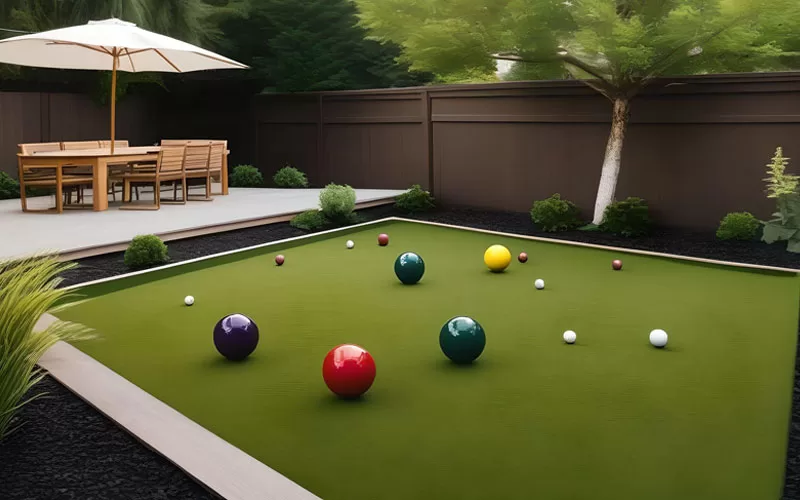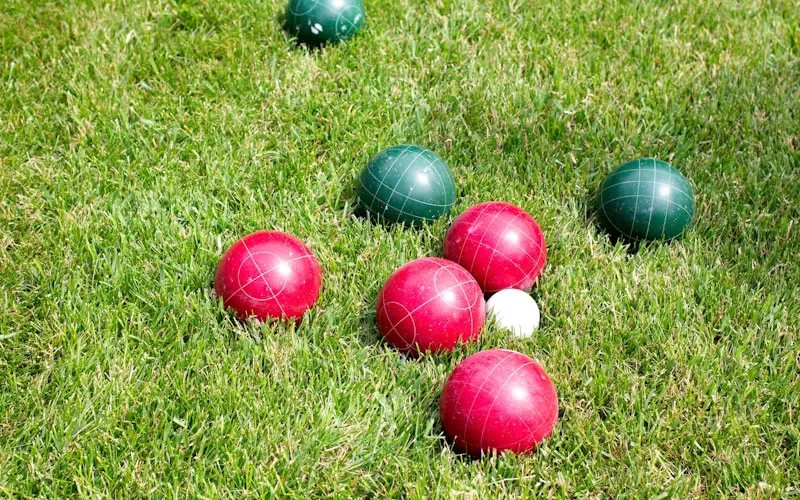
If you’re a bocce ball enthusiast, you know that having a quality court surface can make all the difference in your game. But with so many options available, it can be tough to know what is the best surface for a bocce ball court. Below are some of the top bocce ball court surfaces to consider for your backyard, as well as some tips for installation and maintenance.
Why Court Surface Matters in Bocce Ball
Before we dive into the specific surfaces to consider, let’s take a moment to understand why the court surface is so important in bocce ball.
Consistency
A consistent surface is key in bocce ball, as it allows players to judge their throws’ speed and trajectory accurately. A surface with bumps, divots, or uneven spots can cause the balls to bounce or roll unpredictably, making it difficult to execute strategic plays.
Drainage
Proper drainage is essential for any outdoor bocce ball court. A surface that allows water to pool or remain stagnant can lead to damage over time and create unsafe playing conditions. Look for surfaces that allow water to drain quickly and efficiently.
Durability
A bocce ball court surface should be able to withstand regular use and exposure to the elements. Look for surfaces that are resistant to cracking, fading, and other types of damage so you can enjoy your court for years to come.

Top Bocce Ball Court Surfaces to Consider
Now that we understand the importance of court surface, let’s take a closer look at some of the top options to consider for your backyard bocce ball court.
Natural Soil and Oyster Shell Blend
A blend of natural soil and crushed oyster shells is a popular choice for bocce ball court surfaces. This traditional Italian surface provides a smooth, fast-playing surface that is easy to maintain. The crushed oyster shells help with drainage and prevent the surface from becoming too compact over time. However, this surface may require more frequent watering and leveling to maintain optimal playing conditions.
Synthetic Turf
Synthetic turf is a low-maintenance option that provides a consistent, even playing surface. Look for turf specifically designed for bocce ball courts, with a shorter pile height and a dense, firm surface. Synthetic turf can be customized with different colors and designs and requires minimal upkeep beyond occasional brushing and rinsing. However, it can be a more expensive option upfront compared to natural surfaces.
Decomposed Granite
Decomposed granite, or DG, is a popular choice for bocce ball court surfaces due to its durability and natural appearance. DG is made from finely crushed granite and provides a firm, stable surface that drains well. It can be compacted to create a smooth, even playing surface and is relatively low maintenance. However, DG may require occasional leveling and replenishment to maintain optimal playing conditions.
Asphalt or Concrete
Consider an asphalt or concrete surface for your bocce ball court for a more permanent and durable option. These surfaces provide a consistent, even playing surface that is easy to maintain and can withstand heavy use. However, they can be more expensive to install and may require professional surfacing to ensure optimal playing conditions. Asphalt or concrete surfaces may also be less forgiving on players’ joints compared to natural or turf surfaces.

Factors to Consider When Choosing a Bocce Ball Court Surface
When deciding on the best surface for your backyard bocce ball court, there are a few key factors to consider:
Budget
The cost of installing a bocce ball court can vary widely depending on the surface you choose and the size of your court. Generally, natural surfaces like soil and oyster shell blends are the most affordable, while synthetic turf and hardscape surfaces like asphalt or concrete are more expensive. Consider your budget and long-term maintenance costs when making your decision.
Climate
The climate in your area can also impact your choice of court surface. If you live in an area with frequent rainfall or humidity, consider prioritizing surfaces with good drainage, such as DG or synthetic turf. If you live in a dry, arid climate, a natural soil and oyster shell blend may be a good choice to help retain moisture.
Intended Use
Consider how often your bocce ball court will be used and by whom. If you plan on hosting frequent tournaments or large gatherings, a more durable surface like asphalt or concrete may be a good investment. A natural surface or synthetic turf may suffice if your court will primarily be used for casual play with family and friends.
Maintenance
Different court surfaces require different levels of maintenance to keep them in top playing condition. Natural surfaces like soil and oyster shell blends may require more frequent watering, leveling, and replenishment, while synthetic turf and hardscape surfaces are generally maintained less frequently. Consider your available time and resources for court upkeep when making your decision.
Tips for Installing and Maintaining Your Bocce Ball Court Surface
Once you’ve chosen the best surface for your backyard bocce ball court, it’s important to properly install and maintain it to ensure optimal performance and longevity. Here are a few tips to keep in mind:
Hire a Professional
While some handy homeowners may be tempted to install their own bocce ball court, hiring a professional with experience in court construction is generally recommended. A professional can ensure that your court is properly graded, leveled, and surfaced for optimal playing conditions and drainage.
Follow Manufacturer Guidelines
If you’re installing a synthetic turf or hardscape surface, be sure to follow the manufacturer’s guidelines for installation and maintenance. This may include specific requirements for base preparation, drainage, and cleaning.
Regularly Inspect and Maintain Your Court
Regular inspection and maintenance are key to keeping your bocce ball court in top condition regardless of your chosen surface. Look for any signs of damage, unevenness, or drainage issues and address them promptly. Regular cleaning, leveling, and replenishment can extend the life of your court and ensure optimal playing conditions.
Use Proper Equipment
Using the right equipment can also help maintain the quality of your bocce ball court surface. Look for bocce balls that are the appropriate size and weight for your surface type, and consider using a court groomer or broom to keep the surface smooth and even.
Conclusion
Choosing the best bocce ball court surface for your backyard depends on your needs, budget, and preferences. Whether you opt for a traditional soil and oyster shell blend, a low-maintenance synthetic turf, or a durable hardscape surface, prioritizing consistency, drainage, and durability will help ensure a high-quality playing experience for years to come. By properly installing and maintaining your court surface, you can create a beautiful and functional space for enjoying the timeless game of bocce ball with family and friends.
Leave a Reply